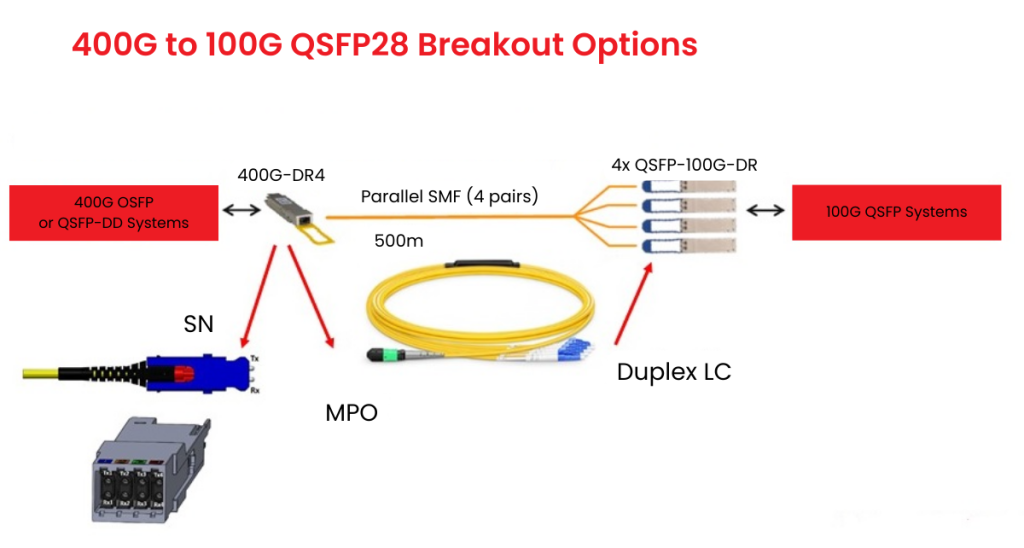To address the massive bandwidth demands placed on network providers, data centers are continuing to transition to faster infrastructures. 400G optical transceivers were designed to meet these high-speed connectivity needs.
400G QSFP-DD optical transceivers come in various flavors: SR8, DR4, FR4, LR4, and more. QSFP-DD DR4 has a key advantage in that it can interoperate with 100G single lambda optics. The PMD in IEEE802.3bs Clause 124 defines a DR4 transmitting a 400Gb/s aggregated signal on 4 fibers (PSM4). These 4 separated independent lanes transport a 100Gb/s each in PAM4 signal format up to a distance of 500m with single mode fiber with KP4 FEC.
The 100G DR1 in IEEE802.3cd is referred to as 100G-single lambda, which runs at 100Gb/s in PAM4 on a single wavelength. The intended use for the DR1 is to interface with the 400G DR4.
Read more about the 100G QSFP28 Single Lambda Transceivers >

In the image (left), a 400G QSFP-DD can connect to four separate 100G QSFP-DR modules with a breakout cable. Note that the transceivers on the 100G side are not limited to DR1, they can be LR1 or FR1.
400G DR4 transceivers typically come with MPO connectors but there are transceivers on the market now with SN connectors which are specially designed for breakout applications.
Benefits
This interoperability between 400G and 100G allows for greater flexibility for network upgrades. If you are upgrading your network from 100G to 400G, you need a cost-effective way to connect new equipment to what already exists in your data center. 400G DR4 optics offers you the ability to upgrade just one site with 400G host platforms and still connect it to existing 100G sites.
Tips to keep in mind
In order to breakout one 400G-DR4 into four 100G-DR1, there are a few key things to keep in mind:
- The 100G Ethernet lanes are independent and can be asynchronous to each other.
- Each of the four lanes may not be active.
- There are registers to check to make sure the transceiver DUT supports what the equipment wants to do and the equipment follows the compliance codes.
The most frequent mistake in operating the 1-λ transceivers is to have FEC on the host side.
In the extended ID field, A0(00).192 which is defined in SFF-8024, identifies the Extended Specification Compliance Code for the transceiver:
- A0(0).0xC0=25h 100GBASE-DR1, CAUI-4 (no FEC)
- A0(0).0xC0=26h 100GBASE-FR1, CAUI-4 (no FEC)
- A0(0).0xC0=27h 100GBASE-LR1, CAUI-4 (no FEC)
Summary
To conclude, 100G Single lambda transceivers offer an easy upgrade path to 400G. 400G QSFP-DD DR4 with its unique architecture lends itself as an ideal candidate for breakout applications without deploying complex Mux/Demux equipment.
If you have any questions on using breakout with 400G transceivers, contact us.
Related Products



